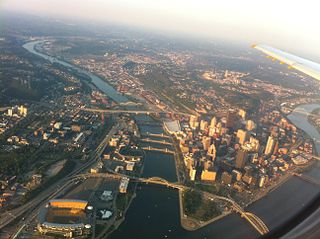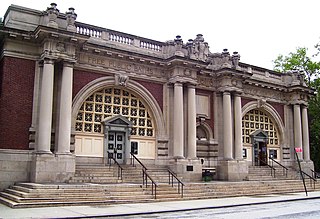
The University of Bath is a public research university located in Bath, Somerset, United Kingdom. It received its royal charter in 1966, along with a number of other institutions following the Robbins Report. Like the University of Bristol and University of the West of England, Bath can trace its roots to the Merchant Venturers' Technical College, established in Bristol as a school in 1595 by the Society of Merchant Venturers. The university's main campus is located on Claverton Down, a site overlooking the city of Bath, and was purpose-built, constructed from 1964 in the modernist style of the time.

Fallingwater is a house designed by the architect Frank Lloyd Wright in 1935 in the Laurel Highlands of southwest Pennsylvania, about 70 miles (110 km) southeast of Pittsburgh. It is built partly over a waterfall on Bear Run in the Mill Run section of Stewart Township, Fayette County, Pennsylvania. The house was designed to serve as a weekend retreat for Liliane and Edgar J. Kaufmann, the owner of Pittsburgh's Kaufmann's Department Store.

Squirrel Hill is a residential neighborhood in the East End of Pittsburgh, Pennsylvania, United States. The city officially divides it into two neighborhoods, Squirrel Hill North and Squirrel Hill South, but it is almost universally treated as a single neighborhood.

The Hill District is a grouping of historically African American neighborhoods in the City of Pittsburgh, Pennsylvania. Beginning in the years leading up to World War I, "the Hill" was the cultural center of black life in the city and a major center of jazz. Despite its cultural and economic vibrancy, in the mid-1950s a substantial area was slated for redevelopment, displacing about 8,000 individuals.

Public baths originated when most people in population centers did not have access to private bathing facilities. Though termed "public", they have often been restricted according to gender, religious affiliation, personal membership, and other criteria. In addition to their hygienic function, public baths have also been social meeting places. They have included saunas, massages, and other relaxation therapies, as are found in modern day spas. As the percentage of dwellings containing private bathrooms has increased in some societies, the need for public baths has diminished, and they are now almost exclusively used recreationally.

The history of the Jews in Pittsburgh dates back to the mid-19th century. In 2002, Jewish households represented 3.8% of households in Allegheny County, Pennsylvania. As of 2017, there were an estimated 50,000 Jews in the Greater Pittsburgh area. In 2012, Pittsburgh's Jewish community celebrated its 100th year of federated giving through the Jewish Federation of Greater Pittsburgh. The city's Jewish federation is one of the oldest in the country, marking the deep historical roots of Jews in Pittsburgh.
Edgar Jonas Kaufmann was an American businessman and philanthropist who owned and directed Kaufmann's Department Store, in Pittsburgh. He is also known for commissioning two modern architectural masterpieces, Fallingwater, designed by Frank Lloyd Wright and the Kaufmann Desert House in Palm Springs, designed by Richard Neutra.

The Point Park Civic Center was a proposed civic center for downtown Pittsburgh, Pennsylvania, United States, where the confluence of the Allegheny and Monongahela Rivers forms the Ohio River. Frank Lloyd Wright designed the structure on a commission from Edgar J. Kaufmann in the late 1940s. Wright initially envisioned a circular building more than 1,000 feet (300 m) in diameter and 175 feet (53 m) tall. The structure, containing an opera house, sports arena, three movie theaters, and a convention hall, was wrapped by a spiraling strip of road. The plan expressed Wright's insistence on bringing the automobile into the social setting. It did not find favor with Pittsburgh authorities.

Liberty Avenue is a major thoroughfare starting in downtown Pittsburgh, Pennsylvania, United States, just outside Point State Park. Liberty Ave. runs through Downtown Pittsburgh, the Strip District, Bloomfield, and ends in the neighborhood of Shadyside at its intersection with Centre Avenue and Aiken Avenue. Liberty Avenue is about 4.3 miles long.

The University of Pittsburgh School of Social Work, one of the 13 schools and colleges within the University of Pittsburgh, is located in the Oakland section of Pittsburgh, Pennsylvania. Its offices are in the world-famous Cathedral of Learning, a forty-story, Gothic style edifice that is the signature building of the university.

The O'Hara Student Center, formerly the Concordia Club, is a three-story, 18,000-square-foot (1,700 m2) building on the campus of the University of Pittsburgh on O'Hara Street in the Oakland neighborhood of Pittsburgh, Pennsylvania. It is a contributing property to the Schenley Farms National Historic District and the City of Pittsburgh Oakland Civic Center Historic District. The building was acquired by the university in mid-December, 2009. and has since been renovated to house academic and student activity programs.

Vladeck Houses is a public housing development built and maintained by the New York City Housing Authority on the Lower East Side of Manhattan.

Qargi, Qasgi or Qasgiq, Qaygiq, Kashim, Kariyit, a traditional large semi-subterranean men's community house' of the Yup'ik and Inuit, also Deg Hit'an Athabaskans, was used for public and ceremonial occasions and as a men’s residence. The Qargi was the place where men built their boats, repaired their equipment, took sweat baths, educated young boys, and hosted community dances. Here people learned their oral history, songs and chants. Young boys and men learned to make tools and weapons while they listened to the traditions of their forefathers.

Julia Schoenfeld was a Jewish-American social worker, writer, and activist. During the period of her settlement work, Schoenfeld became interested in recreation for working girls, a subject on which she became a recognized authority. Her investigation of public dance halls in New York City, undertaken in 1908 while she was secretary of the Committee on the Amusement Resources of Working Girls, was the basis for the model New York City ordinance regulating dance halls. Later, as secretary of the Playground and Recreation Association of America, she conducted dance hall investigations in Boston, Massachusetts, St. Joseph, Missouri, Johnstown, Pennsylvania, and Pittsburgh, Pennsylvania.

Sarah Heinz House was a settlement house in at the corner of Heinz and Ohio streets in Pittsburgh, Pennsylvania, US. It adjoined the H. J. Heinz factories. The house's mission was: to provide wholesome social and recreational opportunities; to utilize leisure time and energy; to study individual requirements and awaken and direct latent ability; to develop Christian character and train for efficient citizenship the young people of the community; to draw together neighborhood residents and friends for mutual helpfulness: to train for service in the community.

Pauline Hanauer Rosenberg was an American progressive activist who devoted her life to advancing the well-being and rights of women, children, and immigrants. She served as the first vice president and second president of the National Council of Jewish Women.

Naomi Deutsch was a professional Registered nurse, the organizer and director of the Public Health Unit of the Federal Children's Bureau of the Department of Labor of Washington, D.C.
Samuel Rosenberg (1896–1972) was an American artist and Professor at Carnegie Mellon University in Pittsburgh, PA. He showed his work at the Museum of Modern Art, the Whitney Museum in New York, the National Academy of Art in Washington, the Corcoran Gallery, and in the Pennsylvania Academy of Fine Arts. He was a beloved art teacher, and some of his students were Mel Bochner, Philip Pearlstein and Andy Warhol.

The Former Pittsburgh Wash House and Public Baths Building is located at 3495 Butler Street in the Lawrenceville neighborhood of Pittsburgh, Pennsylvania. Built in 1904 in the Romanesque Revival architectural style, the building today serves as office space. In 2019, it was listed as a contributing property in the Lawrenceville Historic District.

The Hanauer-Rosenberg residence is located at 417 Lockhart Street in the nationally and locally historic neighborhood of Deutschtown in Pittsburgh, Pennsylvania. Built in 1888 in the Richardsonian Romanesque architectural style, the building was the residence of Pauline Hanauer-Rosenberg, founder of the National Council of Jewish Women. In March 2020, the Pennsylvania Historical & Museum Commission awarded a State Historic Marker at the residence to recognize Rosenberg's work. Also in 2020, the Pennsylvania State Historic Preservation Office determined the residence eligible to be listed on the National Register of Historic Places. In May 2020, Preservation Pittsburgh nominated the residence to be considered a City of Pittsburgh Historic Landmark and in July 2020, the City of Pittsburgh's Historic Review Commission determined that this nomination was viable.





















